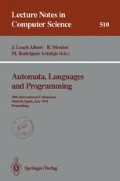Abstract
We introduce new techniques to generate real-world images. Many of the natural images exhibit a hierarchical structure and a balanced combination of both order and chaos. We show how a controlled use of deterministic chaos yields a powerful method to concisely describe and to efficiently generate complex realistic images. The basic technique is the use of mutually recursive function systems (MRFS) possibly with additional control on the order of computations. Then we show that, surprisingly, regular sets of control sequences are convenient but not essential. Some examples are presented illustrating the power of the technique. It is also shown that the images generated by uniformly growing L-systems can be more effectively generated by MRFS, and that every L-system can be simulated if we use a control set produced by an iterative GSM.
Extended Abstract
This research was supported by the National Sciences Foundation under Grant No. CCR-8702752.
Preview
Unable to display preview. Download preview PDF.
References
J. Allouche and O. Salon, “Finite Automata, Quasicrystals, and Robinson Tilings,” in Quasicrystals, Networks and Molecules of Fivefold Symmetry, Istvan Nagittai Ed., VCH Publishers, 1990.
D. Arques, G. Eyrolles, N. Janey and X. G. Viennot, “Combinatorial Analysis of Ramified Patterns and Computer Imagery of Trees,” Computer Graphics 23, pp. 31–40, Proc. SIGGARPH'89.
F. Axel, “Controlled Disorder Generated by Substitutions or Finite Automata: The State of the Art,” 3rd International meeting on quasicrystals, incommensurate structures in condensed matter, Mexico (1989).
M. F. Barnsley, Fractals Everywhere, Academic Press, 1988.
M. F. Barnsley, J. H. Elton and D. P. Hardin, “Recurrent Iterated Function Systems,” Constructive Approximation, 5 3–31 (1989).
M. F. Barnsley, A. Jacquin, L. Reuter and A. D. Sloan, “Harnessing Chaos for Image Synthesis,” Computer Graphics, Proc. SIGGARPH'88.
M. F. Barnsley, R. L. Devaney, B. B. Mandelbrot, H-O. Peitgen, De Saupe, and R. F. Voss, Science of Fractal Images, Springer-Verlag, 1988.
J. Berstel and M. Morcrette, “Compact Representation of Patterns by Finite Automata,” Proceedings Pixim'89, Paris, pp. 387–402.
L. Boasson and M. Nivat, “Adherences of Languages,” Jour. of Computer Syst. Sci., 20, pp. 285–309 (1980).
K. Culik II and S. Dube, “Affine Automata and Related Techniques for Generation of Complex Images,” Technical Report TR90009, Dept. of Computer Science, Univ. of S. Carolina. Preliminary version in Proc. of MFCS'1990. Lecture Notes in Computer Science 452, Springer-Verlag 1990, pp. 224–231.
K. Culik II and S. Dube, “Rational and Affine Expressions for Image Synthesis,” Technical Report TR90010, Dept. of Computer Science, Univ. of S. Carolina. Preliminary version in Proc. of FST-TCS'1990. Lecture Notes in Computer Science 472, Springer-Verlag 1990, pp. 76–90.
K. Culik II and S. Dube, “Balancing Order and Chaos in Image Generation,” Technical Report TR 9103, Dept. of Computer Science, Univ. of S. Carolina.
K. Culik II and J. Karhumäki, “Iterative devices generating infinite words,” manuscript.
K. Culik II and S. Yu, “Cellular Automata, ωω-Regular Sets, and Sofic Systems,” to appear in Discrete Applied Mathematics.
F. M. Dekking, “Recurrent Sets,” Advances in Mathematics, 44, 78–104 (1982).
F. M. Dekking, “Recurrent Sets: A Fractal Formalism,” Report 82-32, Delft University of Technology, 1982.
D. B. Ellis and M. G. Branton, “Non-Self-Similar Attractors of Hyperbolic IFS,” in: J. C. Alexander (Ed.), Dynamical Systems, Lecture Notes in Mathematics 1342, pp. 158–171, Springer-Verlag, 1988.
S. Even, Rational Numbers and Regular Events, IEEE Transactions on Electronic Computers, EC-13, No. 6, 740–741 (1964).
J. Gleick, Chaos-Making a New Science, Penguin Books, 1988.
J. Hartmanis and R. E. Stearns, Sets of Numbers Defined By Finite Automata, American Mathematical Monthly 74, 539–542 (1967).
B. Mandelbrot, The Fractal Geometry of Nature, W. H. Freeman and Co., San Francisco, 1982.
P. Prusinkiewicz, “Applications of L-systems to Computer Imagery,” in H. Ehrig, M. Nagl, A. Rosenfeld, and G. Rozenberg, editors, Graph grammars and their application to computer science; Third International Workshop, pages 534–548, Springer-Verlag, Berlin, 1987. Lecture Notes in Computer Science 291.
P. Prusinkiewicz, A. Lindenmayer and J. Hanan, “Developmental Models of Herbacious Plants for Computer Imagery Purposes,” Proc. SIGGRAPH'88, Computer Graphics 22 141–150 (1988).
P. Prusinkiewicz and A. Lindenmayer, The Algorithmic Beauty of Plants, Springer Verlag 1990.
J. Shallit and J. Stolfi, “Two Methods for Generating Fractals”, Comput. & Graphics 13, No. 2, 185–191 (1989).
A. R. Smith III, “Plants, Fractals, and Formal Languages,” Computer Graphics, 18, 1–10 (1984).
L. Staiger, “Quadtrees and the Hausdorff Dimension of Pictures”, Workshop on Geometrical Problems of Image Processing, Georgental GDR, 173–178 (1989).
S. Wolfram, Theory and Applications of Cellular Automata, World Scientific, Singapore (1986).
Author information
Authors and Affiliations
Editor information
Rights and permissions
Copyright information
© 1991 Springer-Verlag Berlin Heidelberg
About this paper
Cite this paper
Culik, K., Dube, S. (1991). Balancing order and chaos in image generation. In: Albert, J.L., Monien, B., Artalejo, M.R. (eds) Automata, Languages and Programming. ICALP 1991. Lecture Notes in Computer Science, vol 510. Springer, Berlin, Heidelberg. https://doi.org/10.1007/3-540-54233-7_167
Download citation
DOI: https://doi.org/10.1007/3-540-54233-7_167
Published:
Publisher Name: Springer, Berlin, Heidelberg
Print ISBN: 978-3-540-54233-9
Online ISBN: 978-3-540-47516-3
eBook Packages: Springer Book Archive

